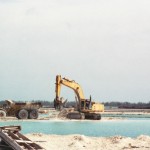 Tourism Concern, the UK’s leading charity which campaigns long and hard to put a stop to exploitation in the travel industry, has given the bigwigs in tourism an ultimatum. Mega-resorts, designed to simply to attract dollars rather than sustainable development, have to stop.
Tourism Concern, the UK’s leading charity which campaigns long and hard to put a stop to exploitation in the travel industry, has given the bigwigs in tourism an ultimatum. Mega-resorts, designed to simply to attract dollars rather than sustainable development, have to stop.
Too often, people’s livelihoods are ignored when the big bucks builders come to town, and ‘suddenly’ planning permission is given to convert farming or fishing communities to hotels, second homes or golf courses. Tricia Barnett of Tourism Concern adds, “The needs and rights of local communities are being pitched directly against those of mega-resorts, with the resorts winning out almost every time”.
According to Tourism Concern, the government of Grenada, for example, has sold off state land for a 400 acre luxury development, including 170 private villas, a private island, golf course and marina. It is located in Mount Hartman National Park, despite being a protected area and the last remaining habitat of the rare Grenada dove. Or in The Bahamas, despite fierce public opposition, the development of Bimini Bay Resort has caused irreparable damage to the marine ecosystem, which local people depend upon for their livelihoods. See www.tourismconcern.org.uk.
Jamaicans are angry too, as illustrated by aptly named website www.jamaicaforsale.net. Jamaican environmentalist Diana McCaulay has teamed up with fellow Jamaican filmmaker Esther Figueroa, to make one of the most powerful films I have ever seen about how extreme tourism development affects local people. Click on the site for lots of interesting clips, featuring interviews with over fifty people involved in tourism, from the Prime Minster to fishermen, scuba divers to stall holders.
However, don’t let this put you off going to these stunning places, just seek out the more responsible ways to do it. In Grenada, for example, eco-lodge Paradise Bay has windmill and solar energy, local food sourcing and social programmes (www. paradisebayresort.net). While you are there, go turtle watching with conservation group Ocean Spirits (www.grenadatours.com/turtlewatch.php), or visit the Fairtrade Chocolate plantation Belmont Estate (www.belmontestate.net). It’s not all gated concrete communities in Jamaica either. Check out www.responsibletravel.com for more interesting options. One of my favourites is Hotel Mocking Bird Hill, in the less touristy Port Antonio, with high standards of environmental practice, as well as sourcing everything locally (www.hotelmockingbirdhill.com). This is one of many featured in Alastair Sawday’s Green Places to Stay, a superb, well-researched guidebook.
Many resorts have responsible tourism policies, but it is hard to see if these are actually implemented until you get there. If you want to travel with a tour operator, First Choice has one of the best track records for responsible tourism policies. Along with My Travel, Thomas Cook, Sunvil or Cosmos, they are supporters of The Travel Foundation, which runs sustainable tourism projects around the world (www.thetravelfoundation.org.uk).
Another option is to sign up with www.yoursafeplanet.com before you book. This inspired website puts you in touch with carefully selected local experts, who have all the best bits of local info, such as which concrete jungles to avoid, the quietest beaches, the best markets, their favourite restaurants, and what to do out of the main tourist season. For £45 sterling you are put in touch with a local expert who will give you pre-departure advice, as well as support while you are there. My other favourite font of knowledge is leading green travel writer Richard Hammond’s www.greentraveller.co.uk.
Until all the big companies are totally transparent about the impact they are having on a destination, I opt for independent travel. That way you can see exactly where your money is going, and meet the people who are making big personal investments into sharing what they love most about their homeland. At the end of the day, that has to be the best way to say no to the bullydozers.
This article was first published in The Irish Times, 21 March 09
